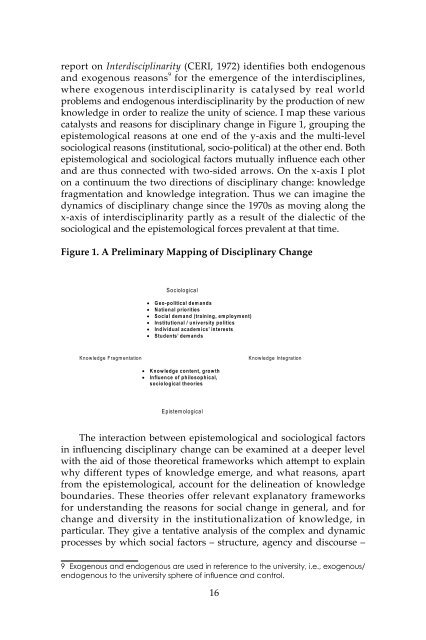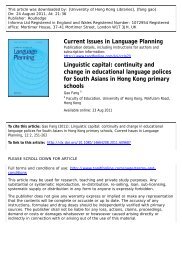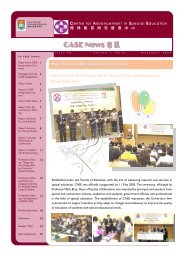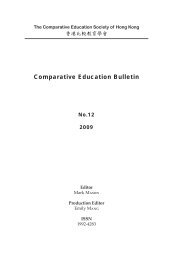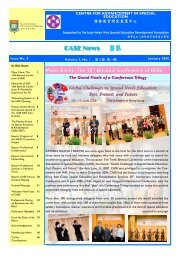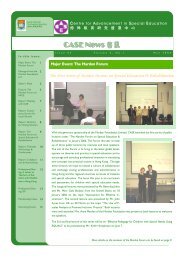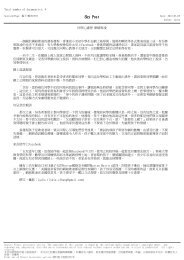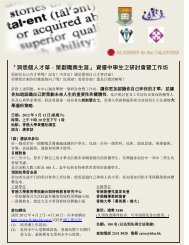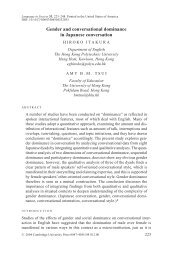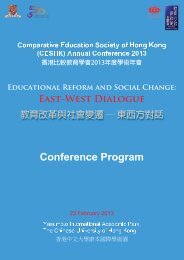Comparative Education Bulletin - Faculty of Education - The ...
Comparative Education Bulletin - Faculty of Education - The ...
Comparative Education Bulletin - Faculty of Education - The ...
Create successful ePaper yourself
Turn your PDF publications into a flip-book with our unique Google optimized e-Paper software.
eport on Interdisciplinarity (CERI, 1972) identifies both endogenous<br />
and exogenous reasons 9 for the emergence <strong>of</strong> the interdisciplines,<br />
where exogenous interdisciplinarity is catalysed by real world<br />
problems and endogenous interdisciplinarity by the production <strong>of</strong> new<br />
knowledge in order to realize the unity <strong>of</strong> science. I map these various<br />
catalysts and reasons for disciplinary change in Figure 1, grouping the<br />
epistemological reasons at one end <strong>of</strong> the y-axis and the multi-level<br />
sociological reasons (institutional, socio-political) at the other end. Both<br />
epistemological and sociological factors mutually influence each other<br />
and are thus connected with two-sided arrows. On the x-axis I plot<br />
on a continuum the two directions <strong>of</strong> disciplinary change: knowledge<br />
fragmentation and knowledge integration. Thus we can imagine the<br />
dynamics <strong>of</strong> disciplinary change since the 1970s as moving along the<br />
x-axis <strong>of</strong> interdisciplinarity partly as a result <strong>of</strong> the dialectic <strong>of</strong> the<br />
sociological and the epistemological forces prevalent at that time.<br />
Figure 1. A Preliminary Mapping <strong>of</strong> Disciplinary Change<br />
S ociological<br />
• G e o -p o litic a l d e m a n d s<br />
• N a tio n a l p rio ritie s<br />
• S o c ia l d e m a n d (tra in in g , e m p lo ym e n t)<br />
• In s titu tio n a l / u n iv e rs ity p o litic s<br />
• In d iv id u a l a c a d e m ic s ’ in te re s ts<br />
• S tu d e n ts ’ d e m a n d s<br />
K now ledge Fragm entation K now ledge Integration<br />
• K n o w le d g e c o n te n t, g ro w th<br />
• In flu e n c e o f p h ilo s o p h ic a l,<br />
s o c io lo g ic a l th e o rie s<br />
E pistem ological<br />
<strong>The</strong> interaction between epistemological and sociological factors<br />
in influencing disciplinary change can be examined at a deeper level<br />
with the aid <strong>of</strong> those theoretical frameworks which attempt to explain<br />
why different types <strong>of</strong> knowledge emerge, and what reasons, apart<br />
from the epistemological, account for the delineation <strong>of</strong> knowledge<br />
boundaries. <strong>The</strong>se theories <strong>of</strong>fer relevant explanatory frameworks<br />
for understanding the reasons for social change in general, and for<br />
change and diversity in the institutionalization <strong>of</strong> knowledge, in<br />
particular. <strong>The</strong>y give a tentative analysis <strong>of</strong> the complex and dynamic<br />
processes by which social factors – structure, agency and discourse –<br />
9 Exogenous and endogenous are used in reference to the university, i.e., exogenous/<br />
endogenous to the university sphere <strong>of</strong> influence and control.<br />
16


